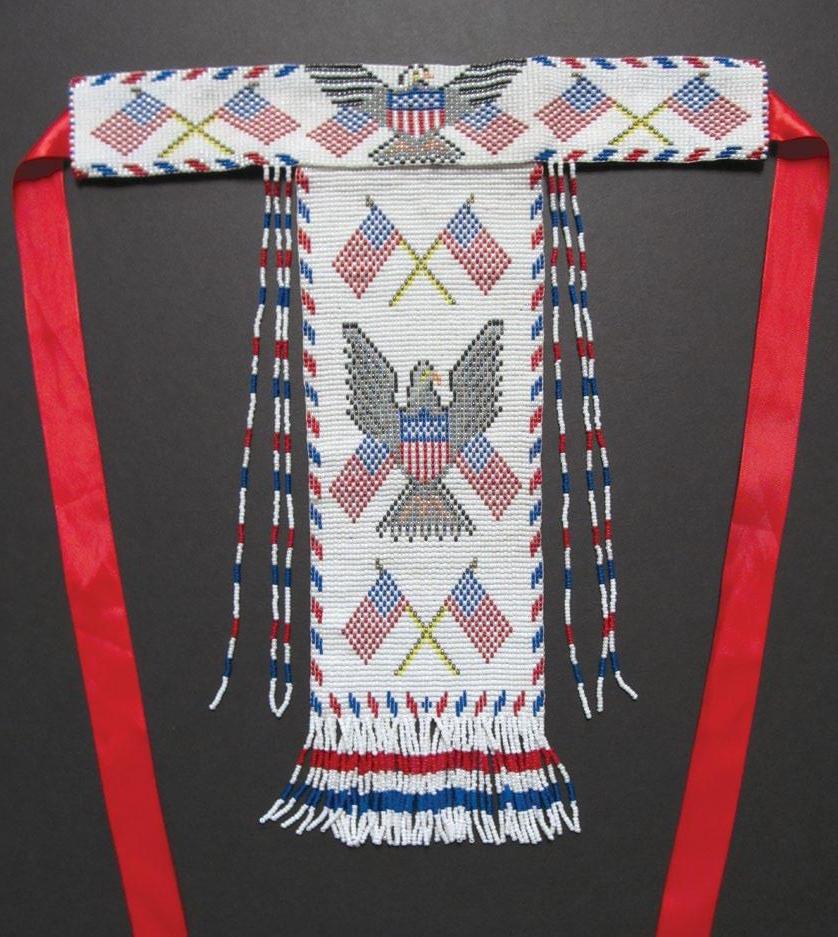
3 minute read
American Flags and Patriotic Symbols in American Indian Art
By T. Wallin
As I sit here writing, I’m thinking about all the celebrations that will be taking place this Fourth of July. There will be picnics, fireworks, and most of all a blaze of red, white, and blue decorations including flags flying from homes and businesses.
A couple of my friends are American Indian art collectors. They specifically collect art with American flag motifs or patriotic symbols such as eagles and U.S.A. Some of their items date to the late 1800s. One might wonder why American Indians, at that period of time, would use the American flag as a design on their clothing or weavings. A few books and academic papers have been written that explain cultural or political reasons and I’ll leave it up to our readers to further investigate. Instead, I’ll focus on the ingenuity, variety and aesthetics of these works of art.
Navajo weavers have been using flags and patriotic symbols in their weavings since the 1870s. The flags might not always have the correct amount of stars and stripes, but it is unmistakably an American flag. Pictorial wall hangings with eagles, shields and United States of America, meticulously woven, are a testament to the creativity and talent of the weavers.
Basketry is another of the arts that can have flags, eagles and wording. I have seen examples of Apache, Mission, Navajo, Paiute and Makah baskets with flag and patriotic symbols. Many are done in red, white and blue, but most utilize natural colors that the weavers would commonly use. A few years ago, one of my collector friends custom-ordered a basket from Southern Paiute weaver, Edith King. He said, “It just needs a flag in it somewhere”. A year later, a fantastic, finely woven basket depicting an eagle with flags as wings came in the mail.

Sioux Child’s moccasins, circa 1900.

Lakota Blanket strip, Late 19th century.
Pottery is one of the arts that rarely has patriotic symbols. A few pieces by Navajo artist, Lorraine Williams, and Hopi-Tewa artists, Jean Sahmie and Vernida Polacca, have shown up only to be snapped up by my collector buddies.
Beadwork is by far the most common media for flag depictions, which can appear on clothing of all types, cradles, bags and horse gear. Grand, elaborate pieces by Sioux artists started to appear in the 1880s and continued through the early Reservation Period. The Plateau tribes, particularly the Yakima and Nez Perce, have created beaded bags with imaginative depictions of flying eagles, shields and flags for over 100 years. The Iroquois around Niagara Falls found a ready market for souvenir-type beaded pin cushions, wall pockets and other “whimseys.” Tourists eagerly bought these items, many of which have American flag motifs. This tradition still continues.
A few other art forms such as Navajo folk carvings and silver jewelry, particularly bolo ties and pins, are occasionally made with patriotic designs. So I asked my friends, “Why collect American flags?” One said that the flag could be considered a symbol of power and that American Indians using flags on items might consider it a form of protection. He also said that cultural differences may melt together as veterans honor the flag and what it stands for. This idea was similar to that of another friend. He said that he collected patriotic American Indian art because, for him, it represented the men and women who had fought and died to make this country what it is. A land of freedom. Enjoy your Independence Day.

Basket is by a Navajo artist, name unknown.

Apache T-necklace is by Charlene Martin.

Fully beaded Sioux cradle, circa 1915.

Hopi-Tewa pottery canteen by Jean Sahmie.

Miniature flag-pattern Navajo beaded medicine pouch measures 3.25” x 4.25”, by Elouise Bia.

Yakima beaded bag (mid-1900s, artist unknown).

Apache burden basket (artist unknown).



